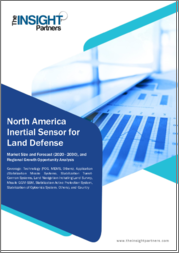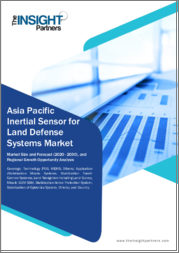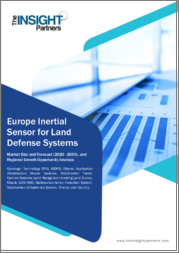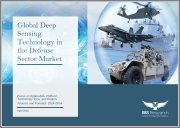
|
시장보고서
상품코드
1402348
군용 센서 시장 : 유형별, 용도별, 최종 용도별, 예측(2023-2032년)Military Sensor Market - By Type, By Application, By End Use & Forecast, 2023 - 2032 |
||||||
세계 군용 센서 시장 규모는 센서 기술의 발전과 군사력 현대화에 대한 관심 증가로 인해 2023-2032년간 6%의 연평균 복합 성장률(CAGR)을 나타낼 것으로 예상됩니다.
국방 시스템이 진화함에 따라 감시, 정찰, 표적에 대한 첨단 센서에 대한 수요가 증가하고 있습니다. 인공지능 및 드론과 같은 혁신적인 기술의 통합은 현대의 안보 과제와 진화하는 전쟁 시나리오에 대응하고 군의 효율성과 효율성을 높여야 하는 필요성에 부응하여 시장 확대를 더욱 가속화할 것으로 보입니다.
기업들은 센서 탑재 드론과 같은 군용 용도를 개발하면서 기술 발전을 통합하고 있습니다. 이러한 전략적 발전은 용도를 확장하고 방어 능력을 강화함으로써 군용 센서 산업을 강화할 것입니다. 예를 들어, 2023년 Teledyne은 은밀한 상황 인식을 향상시키기 위해 강화된 센서를 갖춘 업그레이드된 Black Hornet 4 나노 드론을 발표했습니다. 이 차세대 경량 드론은 이전 모델을 기반으로 소형 군사 유닛에 고급 상황 인식을 제공하는 고급 기능을 갖추고 있습니다.
군용 센서 산업은 유형, 용도, 최종 용도 및 지역으로 분류됩니다.
자이로스코프 분야는 2032년까지 자이로스코프 기술이 군용 용도에서 안정성과 항법 기능을 제공하는 데 중요한 역할을 함에 따라 상당한 견인력을 발휘할 것으로 예상됩니다. 정확성과 신뢰성을 중시하는 자이로스코프는 내비게이션 시스템, 조준 장치 등 다양한 군사 시스템에 필수적인 부품입니다. 전 세계 방위군이 첨단 센서 기술을 우선시하는 가운데, 자이로스코프 분야는 현대 군사 작전의 진화하는 요구 사항을 충족하는 데 있어 중요한 기여자로 부상할 것입니다.
감시, 정찰, 표적을 위한 항공 플랫폼의 센서 기술에 대한 의존도가 높아짐에 따라 항공 부문의 군사 센서 시장 규모는 2032년까지 크게 증가할 것으로 예상됩니다. 현대의 군사 작전이 항공 능력을 중시함에 따라 항공 플랫폼의 첨단 센서에 대한 수요가 증가하고 있습니다. 정교한 센서 시스템의 통합은 상황 인식과 작전 효율성을 향상시켜 군용 센서 산업 환경을 형성하는 데 있어 항공 부문의 매우 중요한 역할을 확고히 하고 있습니다.
유럽의 군사 센서 산업은 2023년부터 2032년까지 높은 CAGR을 보일 것으로 예상됩니다. 이 지역의 중요한 국방 투자는 유명한 국방 계약자의 존재와 결합하여 눈에 띄는 위치에 기여했습니다. 또한 유럽은 군사 센서 기술 혁신에 전념하고 있으며, 감시, 정찰 및 표적 시스템의 발전에 크게 기여하여 세계 군사 센서 시장에서의 우위를 강화하고 있습니다.
목차
제1장 조사 방법과 조사 범위
제2장 주요 요약
제3장 군 센서 업계 인사이트
- COVID-19의 영향
- 러시아·우크라이나 전쟁의 영향
- 업계 생태계 분석
- 벤더 매트릭스
- 이익률 분석
- 기술 및 혁신 전망
- 특허 분석
- 주요 뉴스와 이니셔티브
- 파트너십/협업
- 합병/인수
- 투자
- 제품 출시와 혁신
- 규제 상황
- 영향요인
- 성장 촉진요인
- 업계의 잠재적 리스크와 과제
- 성장 가능성 분석
- Porter의 Five Forces 분석
- PESTEL 분석
제4장 경쟁 구도(2022년)
- 서론
- 기업별 시장 점유율
- 주요 시장 기업의 경쟁 분석
- BAE Systems plc
- Curtiss-Wright Corporation
- Esterline Technologies Corporation
- General Electric Company
- Honeywell International Inc.
- Raytheon Technologies Corporation
- Lockheed Martin Corporation
- 경쟁 포지셔닝 매트릭스
- 전략 전망 매트릭스
제5장 군 센서 시장 추정·예측 : 유형별
- 주요 동향 : 유형별
- 음향 센서
- 플로우 센서
- 힘 센서
- 자이로스코프
- 영상 센서
- 레벨 센서
- 위치 및 변위 센서
- 압력 센서
- 근접 센서
- 온도 센서
- 해상
제6장 군 센서 시장 추정·예측 : 용도별
- 주요 동향 : 용도별
- 전투 작전
- 지휘 통제
- 통신 및 항법
- 전자전
- 정보·감시·정찰(ISR)
- 목표 인식
제7장 군 센서 시장 추정·예측 : 최종 용도별
- 주요 동향 : 최종 용도별
- 항공
- 육상
- 해상
제8장 군 센서 시장 추정·예측 : 지역별
- 주요 동향 : 지역별
- 북미
- 미국
- 캐나다
- 유럽
- 영국
- 독일
- 프랑스
- 이탈리아
- 스페인
- 기타 유럽
- 아시아태평양
- 중국
- 인도
- 일본
- 한국
- 호주 및 뉴질랜드
- 기타 아시아태평양
- 라틴아메리카
- 브라질
- 멕시코
- 기타 라틴아메리카
- 중동 및 아프리카
- 아랍에미리트(UAE)
- 사우디아라비아
- 남아프리카공화국
- 기타 중동 및 아프리카
제9장 기업 개요
- BAE Systems plc
- Curtiss-Wright Corporation
- Esterline Technologies Corporation
- General Electric Company
- Honeywell International Inc.
- Imoerx, Inc.
- Kongsberg Gruppen ASA
- Lockheed Martin Corporation
- Microflown Avisa B.V.
- Raytheon Technologies Corporation
- Rock West Solutions
- TE Connectivity Ltd.
- Thales Group
- Transdigm Group, Inc.
- Ultra Electronics
Global Military Sensor Market will register a 6% CAGR from 2023 to 2032 due to advancements in sensor technologies and an increasing focus on modernizing military capabilities. As defense systems evolve, the demand for cutting-edge sensors in surveillance, reconnaissance, and target acquisition rises. The integration of innovative technologies, such as artificial intelligence and drones, will further amplify the market's expansion, addressing the imperative to enhance military efficiency and effectiveness in response to modern security challenges and evolving warfare scenarios.
Companies are integrating technological advancements while developing military applications such as sensor-equipped drones. This strategic development bolsters the military sensor industry by expanding its applications and bolstering defense capabilities. For instance, in 2023, Teledyne introduced the upgraded Black Hornet 4 nano-drone, featuring enhanced sensors for improved covert situational awareness. This next-generation lightweight drone builds upon its predecessor, offering advanced capabilities to provide small military units with heightened awareness.
The military sensor industry is classified based on type, end-use, and region.
The gyroscopes segment will experience remarkable traction by 2032, driven by the crucial role gyroscopic technology plays in providing stability and navigation in military applications. With a focus on precision and reliability, gyroscopes are integral components in various military systems, including navigation systems and targeting devices. As defense forces worldwide prioritize advanced sensor technologies, the gyroscopes segment will emerge as a key contributor to meeting the evolving demands of modern military operations.
The military sensor market size from the airborne segment will witness a substantial upswing by 2032, fueled by the growing reliance on sensor technologies in airborne platforms for surveillance, reconnaissance, and target acquisition. As modern military operations emphasize aerial capabilities, the demand for advanced sensors on airborne platforms rises. The integration of sophisticated sensor systems enhances situational awareness and operational efficiency, solidifying the airborne segment's pivotal role in shaping the landscape of the military sensor industry.
Europe military sensor industry will demonstrate a significant CAGR from 2023 to 2032, attributed to its robust defense infrastructure and strategic technological advancements. The region's significant defense investments, coupled with the presence of renowned defense contractors, contribute to its prominent position. Additionally, Europe's commitment to innovation in military sensor technologies will position it as a major contributor to advancements in surveillance, reconnaissance, and targeting systems, reinforcing its prominence in the global military sensor market.
Table of Contents
Chapter 1 Methodology & Scope
- 1.1 Market scope & definition
- 1.2 Base estimates & calculations
- 1.3 Forecast calculation
- 1.4 Data Sources
- 1.4.1 Primary
- 1.4.2 Secondary
- 1.4.2.1 Paid sources.
- 1.4.2.2 Public sources
Chapter 2 Executive Summary
- 2.1 Military sensor market 360 degree synopsis, 2018 - 2032
- 2.2 Business trends
- 2.2.1 Total Addressable Market (TAM), 2023-2032
- 2.3 Regional trends
- 2.4 Type trends
- 2.5 Application trends
- 2.6 End-use trends
Chapter 3 Military Sensor Industry Insights
- 3.1 Impact on COVID-19
- 3.2 Russia- Ukraine war impact
- 3.3 Industry ecosystem analysis
- 3.4 Vendor matrix
- 3.5 Profit margin analysis
- 3.6 Technology & innovation landscape
- 3.7 Patent analysis
- 3.8 Key news and initiatives
- 3.8.1 Partnership/collaboration
- 3.8.2 Merger/Acquisition
- 3.8.3 Investment
- 3.8.4 Product launch and innovation
- 3.9 Regulatory landscape
- 3.10 Impact forces
- 3.10.1 Growth drivers
- 3.10.1.1 Increasing military modernization programs
- 3.10.1.2 Development of new sensor technologies
- 3.10.1.3 Increasing cyber threats
- 3.10.1.4 Growing adoption of unmanned vehicles
- 3.10.1.5 Ongoing conflicts and geopolitical tensions drive investments in military sensors
- 3.10.2 Industry pitfalls & challenges
- 3.10.2.1 Integration and Interoperability
- 3.10.2.2 Technological Complexity
- 3.10.1 Growth drivers
- 3.11 Growth potential analysis
- 3.12 Porter's analysis
- 3.13 PESTEL analysis
Chapter 4 Competitive Landscape, 2022
- 4.1 Introduction
- 4.2 Company market share, 2022
- 4.3 Competitive analysis of major market players, 2022
- 4.3.1 BAE Systems plc
- 4.3.2 Curtiss-Wright Corporation
- 4.3.3 Esterline Technologies Corporation
- 4.3.4 General Electric Company
- 4.3.5 Honeywell International Inc.
- 4.3.6 Raytheon Technologies Corporation
- 4.3.7 Lockheed Martin Corporation
- 4.4 Competitive positioning matrix, 2022
- 4.5 Strategic outlook matrix, 2022
Chapter 5 Military Sensor Market Estimates & Forecast, By Type (Revenue) and Volume (Units)
- 5.1 Key trends, by type
- 5.2 Acoustic sensors
- 5.3 Flow sensors
- 5.4 Force sensors
- 5.5 Gyroscopes
- 5.6 Image Sensors
- 5.7 Level Sensors
- 5.8 Position or Displacement Sensors
- 5.9 Pressure Sensors
- 5.10 Proximity Sensors
- 5.11 Temperature Sensors
- 5.12 Naval
Chapter 6 Military Sensor Market Estimates & Forecast, By Application (Revenue) and Volume (Units)
- 6.1 Key trends, by application
- 6.2 Combat operations
- 6.3 Command and control
- 6.4 Communication and Navigation
- 6.5 Electronic Warfare
- 6.6 Intelligence, Surveillance & Reconnaissance (ISR)
- 6.7 Target Recognition
Chapter 7 Military sensor Market Estimates & Forecast, By End-use (Revenue) and Volume (Units)
- 7.1 Key trends, by end-use
- 7.2 Airborne
- 7.3 Land
- 7.4 Naval
Chapter 8 Military Sensor Market Estimates & Forecast, By Region (Revenue) and Volume (Units)
- 8.1 Key trends, by region
- 8.2 North America
- 8.2.1 U.S.
- 8.2.2 Canada
- 8.3 Europe
- 8.3.1 UK
- 8.3.2 Germany
- 8.3.3 France
- 8.3.4 Italy
- 8.3.5 Spain
- 8.3.6 Rest of Europe
- 8.4 Asia Pacific
- 8.4.1 China
- 8.4.2 India
- 8.4.3 Japan
- 8.4.4 South Korea
- 8.4.5 ANZ
- 8.4.6 Rest of Asia Pacific
- 8.5 Latin America
- 8.5.1 Brazil
- 8.5.2 Mexico
- 8.5.3 Rest of Latin America
- 8.6 MEA
- 8.6.1 UAE
- 8.6.2 Saudi Arabia
- 8.6.3 South Africa
- 8.6.4 Rest of MEA
Chapter 9 Company Profiles
- 9.1 BAE Systems plc
- 9.2 Curtiss-Wright Corporation
- 9.3 Esterline Technologies Corporation
- 9.4 General Electric Company
- 9.5 Honeywell International Inc.
- 9.6 Imoerx, Inc.
- 9.7 Kongsberg Gruppen ASA
- 9.8 Lockheed Martin Corporation
- 9.9 Microflown Avisa B.V.
- 9.10 Raytheon Technologies Corporation
- 9.11 Rock West Solutions
- 9.12 TE Connectivity Ltd.
- 9.13 Thales Group
- 9.14 Transdigm Group, Inc.
- 9.15 Ultra Electronics



















